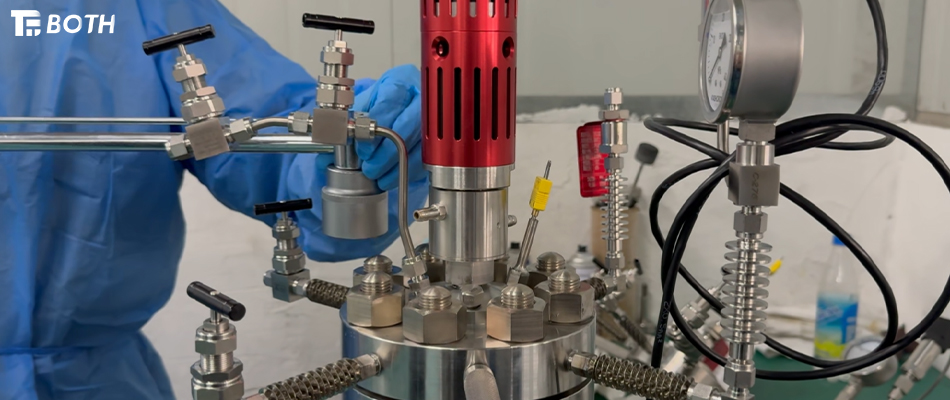High-pressure reactors are crucial reaction equipment in chemical production. During chemical processes, they provide the necessary reaction space and conditions. It is important to pay attention to the following points during the installation of a high-pressure reactor before use:
1.Installation and Sealing of the Reactor Lid
If the reactor body and lid use a conical and arc surface line contact sealing method, the main bolts should be tightened to ensure a good seal. However, when tightening the main bolts, the torque should not exceed 80–120 NM to prevent damage to the sealing surface and excessive wear. Special care should be taken to protect the sealing surfaces. During the installation of the reactor lid, it should be slowly lowered to prevent any impact between the sealing surfaces of the lid and body, which could damage the seal. When tightening the main nuts, they should be tightened in a symmetrical, multi-step process, gradually increasing the force to ensure a good sealing effect.
2.Connection of Locknuts
When connecting the locknuts, only the locknuts themselves should be rotated, and the two arc surfaces should not rotate relative to each other. All threaded connection parts should be coated with oil or graphite mixed with oil during assembly to prevent seizing.

3.Use of Valves
Needle valves use line seals, and only slight turning of the valve needle is needed to compress the sealing surface for an effective seal. Over-tightening is strictly prohibited as it can damage the sealing surface.
4.High-Pressure Reactor Controller
The controller should be placed flat on the operating platform. Its working environment temperature should be between 10°C and 40°C, with a relative humidity of less than 85%. It is important to ensure that there is no conductive dust or corrosive gases in the surrounding environment.
5.Checking Fixed Contacts
Before use, check whether the movable parts and fixed contacts on the front and rear panels are in good condition. The top cover should be removable to check for any looseness in the connectors and any damage or rust caused by improper transportation or storage.
6.Wiring Connections
Ensure that all wires are properly connected, including the power supply, controller-to-reactor furnace wires, motor wires, and temperature sensors and tachometer wires. Before powering up, it is recommended to check the wires for any damage and ensure electrical safety.
7.Safety Devices
For reactors with burst disc devices, avoid dismantling or testing them casually. If a burst occurs, the disc must be replaced. It is crucial to replace any burst discs that did not rupture at the rated burst pressure to ensure safe operation.
8.Preventing Excessive Temperature Differences
During reactor operation, rapid cooling or heating should be avoided to prevent cracks in the reactor body due to excessive temperature differences, which could affect safety. Additionally, the water jacket between the magnetic stirrer and the reactor lid should circulate water to prevent demagnetization of the magnetic steel, which would affect the operation.
9.Using Newly Installed Reactors
Newly installed high-pressure reactors (or reactors that have been repaired) must undergo an airtightness test before they can be put into normal use. The recommended medium for the airtightness test is nitrogen or other inert gases. Flammable or explosive gases must not be used. The test pressure should be 1–1.05 times the working pressure, and pressure should be increased gradually. A pressure increment of 0.25 times the working pressure is recommended, with each increment held for 5 minutes. The test should continue for 30 minutes at the final test pressure. If any leakage is found, the pressure should be relieved before performing any maintenance operations. For safety, avoid operating under pressure.
If you are interested in our High Pressure Reactor or have any questions, please feel free to Contact us.
Post time: Jan-10-2025






